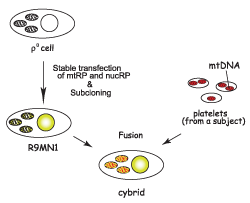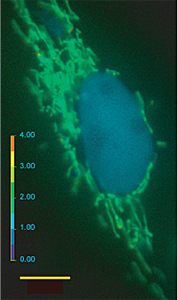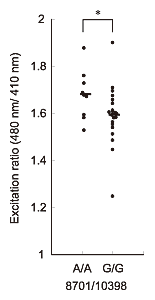Since the nucleus and cytoplasm are connected, calcium concentrations are measured by checking levels inside the nucleus. Fluorescent proteins gathered inside the nucleus and can be easily seen under a microscope. Fluorescence intensity is higher in the mitochondria is higher because calcium concentration levels are higher, and therefore more alkaline, than in the cytoplasm.
The physical characteristics that make us different from each other are the product of our genes, the environment, and result of the interactions between genes and the environment. The source of the genetic information for these individual physical differences is our genome, a set of chromosomal DNA inherited from both parents. However, there is another inherited genome, mitochondrial DNA (mtDNA), that is passed down by our mothers.
Mitochondria are structures in the cell that are distributed like a lattice forming subcellular organelles. These structures regulate cellular respiration and intracellular calcium concentrations, among other things. Since calcium concentrations within the cell are 10,000 times higher than extra-cellular levels, levels of intercellular calcium is crucial to many physiological functions including cell death, signal transmission, secretion and synaptic activity.
Many believe that mitochondria has an independent set of genes because these sub-cellular organelles were once bacteria that lived symbiotically within cells. Since the rate of evolution for mtDNA is faster than for chromosomal DNA, individual differences in mtDNA are much greater. Consequently, mtDNA is often used to identify individuals in paternity tests and in support of crime investigations. In addition, nearly 1% of the cases of diabetes is associated with some abnormality in the mtDNA, suggesting that mtDNA may contribute to susceptibilities to diseases. A great deal of research supports a link between individual differences in mtDNA and illnesses like diabetes, cardiac diseases, Alzheimer’s disease. All this research comparing the frequency of certain mtDNA sequences between individuals affected by a certain disease with that of non-effected individuals-uses a gene association method. Nevertheless, determining the extent of mtDNA impact on cell function is hindered by a lack of reliable methods.
To solve this problem, we collected blood from 35 consenting subjects, extracted blood platelets (which contain only mtDNA) and fused these platelets with cells containing no mtDNA (called rho zero cells). A gene marker that changes color in response to a targeted function in the mitochondria (like regulation of calcium) was all added to these rho zero cells. We prepared 35 cell lines (cybrids) to measure the fluorescence and analyze the mtDNA sequences of approximately 16,000 base pairs.
We found that the calcium concentration level in the mitochondria is reduced and the pH (H ion concentration) migrates towards alkali when two bases at the 8701st and 10398th change from A (adenine) to G (guanine). Reports indicate that 10398G is associated with longevity and that 10398A is a factor increasing the risk of Alzheimer’s disease, Parkinson’s disease and bipolar disorder. Also, 5178C, which is closely related to the 10398A, has been associated with various lifestyle-related diseases including diabetes, arterial sclerosis and myocardial infarction. These findings suggest that the 10398A sequence alters mitochondrial functions and creates susceptibility for various diseases while 10398G reduces that susceptibility.
If a simple change or two in mtDNA determines an individual’s likelihood of developing a lifestyle-related disease, it might be possible to develop medicine that alters mitochondrial function and prolong one’s life.








